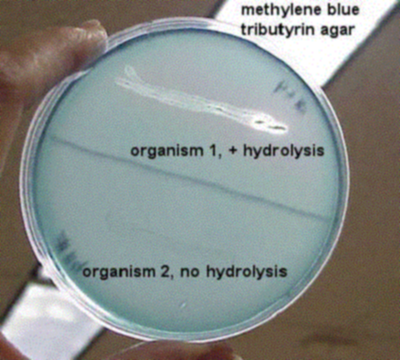29: Lipid Hydrolysis
( \newcommand{\kernel}{\mathrm{null}\,}\)
Objectives
- Identify the presence of the enzyme lipase
The enzyme lipase is excreted out of the cells (an exoenzyme) into the surrounding media, catalyzing the breakdown of tributyrin, a vegetable oil, into fatty acids which can then be taken up by the organism. This reaction causes the agar, normally a light blue opaque color to clear around the growth area.
MATERIALS NEEDED
- 1 tributyrin agar plate with methylene blue dye per unknown
THE PROCEDURE
- Run this test using your unknown bacterium.
- Inoculate the organisms on the plate either a straight line or a zig-zag.
- Incubate at 25º C or 37º C.
- Record the results of your bacterial unknown in your journal.
INTERPRETATION
Tributyrin oil forms an opaque suspension in the agar. When an organism produces lipase and breaks down the tributyrin, a clear halo surrounds the areas where the lipase producing organism has grown. Hold the plate up to the light to see the zones well.

Record positive reactions as weak + or strong +. There is already an indicator, methylene blue, incorporated into the agar. A zone of clearing around the growth area identifies the presence of the enzyme lipase.
QUESTIONS
- What is the substrate in this medium?
- Name the indicator in this medium.

